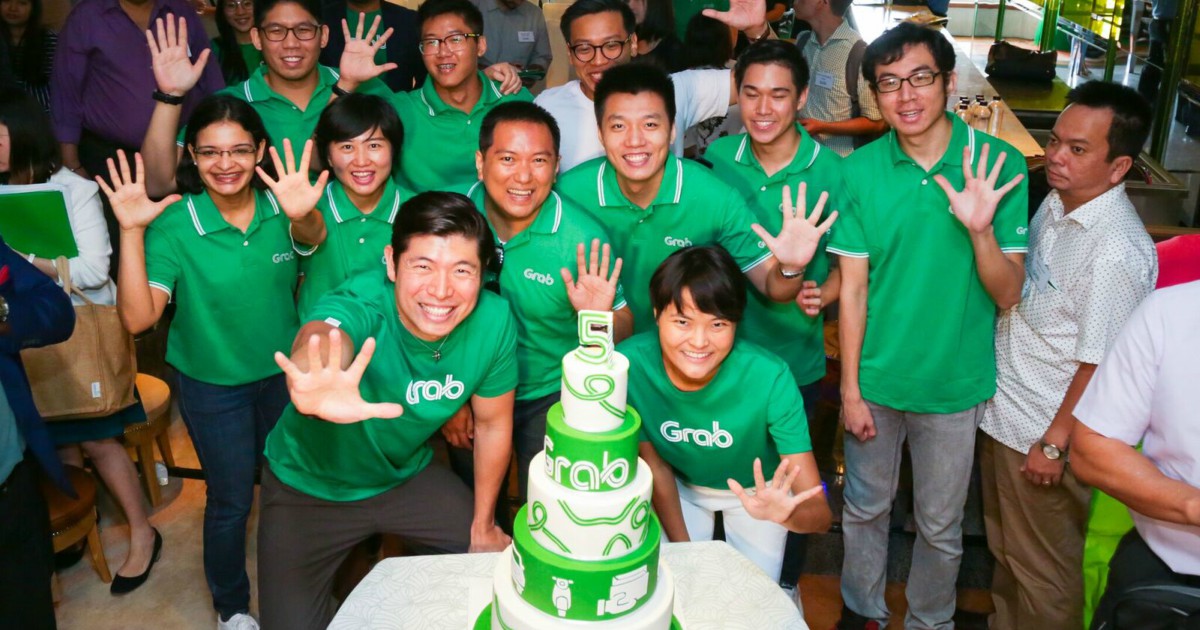This morning, Grab’s co-founders Anthony Tan and Tan Hooi Ling took the stage at a JW Marriott Singapore conference room to kickoff their 5th birthday.

Founded in 2013, the startup has since enjoyed impressive growth.
Despite having to contend with rivals in Uber and Go-Jek, the Malaysian-born, Singapore-headquartered startup now has become the region’s largest ride-hailing startup.
When it first launched in 2013, the startup clocked 67,000 passengers, and now in 2017, Grab has ferried an estimated number of 45 million passengers – and we haven’t even gotten through the first half of the year.
By using the app, Grab commuters are able to save an average of 52% on travel time – with Singapore enjoying a 37% shaving of travel time. With respect to the number of drivers, the startup has also swelled that number from 2000 in 2013 to 930,000 in 2017.
For Grab, success is not just all about the money – though it’s a resource the company is stockpiling in their recent Series E ($350million) and Series F ($750million) – as well as a future $1.5 billion on the horizon.
Instead, co-founder and CEO Anthony Tan talks about how they plan to make Grab part of a lifestyle.
Building A Lifestyle Of Grab
Beginning with the basic function of ride-hailing, the startup has progressively expanded in car sharing services like GrabShare, as well as their latest taxi-pooling service JustGrab.
But what many of us consider just a ride-hailing app isn’t exactly so; or rather, it only paints half the picture of what Grab plans to be.
The Grab app has already seen 45million downloads, and although this isn’t a direct translation to 45million people using GrabPay, it does result in what Jerald Singh, Grab’s Head of Product, calls “sticky customers”.
“Grab users already know that GrabPay is a payments platform that they can trust,” Singh shares.

What this means is that when Grab decides to expand into other verticals of e-commerce (plans already in the works), the GrabPay platform also becomes a channel they can rely on.
This can be seen with GrabRewards, the tiered rewards platform many of us already enjoy for discounts.
By building up the brands and merchant database on the platform, this once simple ride-hailing app has already taken its first steps to becoming a lifestyle app.
And with good reason.
According to a 2016 report by Google and Temasek, Grab has massive potential for growth in Southeast Asia.
By 2025, the number of rides they facilitate can multiply fivefold, likely bringing in 13 billion of annual revenue and boost their addressable market to 5oo billion. By building themselves up as a multi-vertical platform, Grab has the potential to become a veritable giant.
Not to mention that for individuals travelling overseas, the GrabPay platform becomes a seamless, and universal, payment mode for cashless rides.
Of course, the reliance on GrabPay is subjective to country, as not every country with Grab automatically includes GrabPay. Meanwhile, countries like Malaysia tend to be less reliant on mobile wallets for security reasons, and instead fall back on credits and cash.
New App Features
In Singapore, Tan also announced the release of the telematics arm – a database meant to serve as pre-emptive safety features for Grab drivers.
How the telematics work is that it records instances of speeding, hard braking and dangerous swerving amongst other risky driving behaviour.

All this data is saved and once a particular driver has shown a consistent level of such behaviour, he or she will be duly notified through weekly reports of safety scores.
First launching in Singapore, the telematics function will be rolled out progressively to other countries.
Grab already boasts higher than average safety numbers, with traffic accident rates 6 times lower than average in Vietnam and Malaysia. With the integration of telematics, Grab users can look forward to these numbers dropping even further in the future.
With their anniversary celebration, Tan also announced new changes to GrabChat – auto-translation of template messages in 5 languages (Bahasa Indonesia, Bahasa Melayu, Simplified Chinese, Thai and Vietnamese).
The messaging platform has already been crucial in decreasing the number of cancellations, and this new update is believed to value-add the app even further.
From MyTeksi To Global Tech Giant

“When we started in 2012, not everyone wanted to work with us. Most people could not see how this new kid on the block could be a partner instead of a competitor,” shared CEO Anthony Tan in a ‘Letter to Friends‘.
In the letter, he talks about how he and co-founder Tan Hooi Ling and the rest of the team broke through tribulations as they made tough decisions to constantly disrupt themselves.
“Yet despite all the challenges, Ling and I didn’t give up on the idea of Grab. Why? Because we knew that if we succeeded in making our crazy idea work, we would succeed in improving livelihoods, transportation safety and accessibility for millions across Southeast Asia.”
“You can call us crazy, but Grab is a place for crazy people who believe that what we do can improve lives. I hope you will continue to join us on this crazy movement to transform lives through technology, and walk with us for many more 5 years to come.”
Featured Image Credit: Grab








